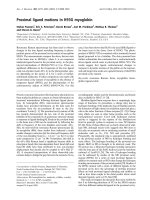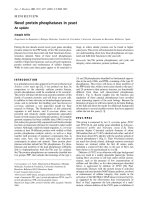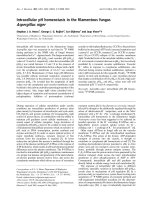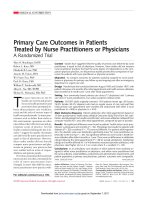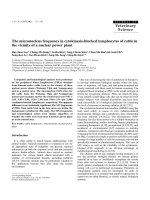Báo cáo y học: "Objective cough frequency in Idiopathic Pulmonary Fibrosis" pot
Bạn đang xem bản rút gọn của tài liệu. Xem và tải ngay bản đầy đủ của tài liệu tại đây (564.41 KB, 7 trang )
Cough
Key et al. Cough 2010, 6:4
/>Open Access
RESEARCH
© 2010 Key et al; licensee BioMed Central Ltd. This is an Open Access article distributed under the terms of the Creative Commons At-
tribution License ( which permits unrestricted use, distribution, and reproduction in any
medium, provided the original work is properly cited.
Research
Objective cough frequency in Idiopathic
Pulmonary Fibrosis
Angela L Key
†1,3
, Kimberley Holt
†1,3
, Andrew Hamilton
†2
, Jaclyn A Smith
†2
and John E Earis*
†1,3
Abstract
Background: Cough is a common presenting symptom in patients with Idiopathic Pulmonary Fibrosis (IPF). This study
measured cough rates in IPF patients and investigated the association between cough and measures of health related
quality of life and subjective cough assessments. In addition, IPF cough rates were related to measures of physiological
disease severity and compared to cough rates in health and other respiratory conditions.
Methods: Nineteen IPF patients, mean age 70.8 years ± 8.6, five female (26.3%) were studied. Subjects performed full
pulmonary function testing, 24 hour ambulatory cough recordings, completed a cough related quality of life
questionnaire (Leicester Cough Questionnaire) and subjectively scored cough severity with a visual analogue scale.
Ambulatory cough recordings were manually counted and reported as number of coughs per hour.
Results: The 24hr cough rates were high (median 9.4, range 1.5-39.4), with day time rates much higher than night time
(median 14.6, range 1.9-56.6 compared to 1.9, range 0-19.2, p = 0.003). Strong correlations were found between
objective cough frequency and both the VAS (day r = 0.80, p < 0.001, night r = 0.71, p = 0.001) and LCQ (r = -0.80, p <
0.001), but not with measures of pulmonary function. Cough rates in IPF were higher than healthy subjects (p < 0.001)
and asthma patients (p < 0.001) but similar to patients with chronic cough (p = 0.33).
Conclusions: This study confirms objectively that cough is a major, very distressing and disabling symptom in IPF
patients. The strong correlations between objective cough counts and cough related quality of life measures suggest
that in IPF patient's, perception of cough frequency is very accurate.
Background
Idiopathic Pulmonary Fibrosis (IPF) is a progressive
fibrotic disease of unknown aetiology with an estimated
incidence of 6-20 cases per 100,000 of the population.
Clinical features include dry cough, breathlessness,
restrictive spirometry, end-inspiratory crackles, reduced
oxygenation and finger clubbing. High resolution com-
puter tomography (HRCT) shows a distinctive pattern of
sub pleural shadowing and later in the disease honey-
comb fibrosis [1]. Cough in IPF, is both a presenting and a
complicating clinical feature [2].
Swigris et al conducted in-depth interviews with IPF
patients to determine how the disease affects their lives
[3]. They described cough as being dry, nonproductive
and hacking with significant physical and social impacts
on their lives. Moreover there is often a constant urge to
cough which was unrelieved by coughing [3]. Other
reports confirmed these observations and suggest that
cough affects 73-86% of cases [4,5].
To date there are no studies objectively quantifying
cough in IPF patients. The aims of this study were to
measure cough rates in subjects with IPF and investigate
the relationships between objective cough rates, subjec-
tive cough assessments and cough related quality of life.
Any association between cough rates and measures of
disease severity were also explored. Finally cough rates in
IPF were compared to previously published data, col-
lected using identical methodology in healthy controls,
asthma and isolated chronic cough [6,7].
Methods
Subjects
Nineteen patients were recruited from two specialist
Interstitial Lung Disease (ILD) clinics at University Hos-
* Correspondence:
1
Respiratory Department, Aintree University Hospitals NHS Foundation Trust,
University Hospital Aintree, Longmoor Lane Liverpool, L9 7AL, UK
†
Contributed equally
Full list of author information is available at the end of the article
Key et al. Cough 2010, 6:4
/>Page 2 of 7
pital Aintree (UHA) and University Hospital South Man-
chester (UHSM). All patients met ATS/ERS criteria for
the diagnosis of IPF i.e. demonstrated typical clinical,
spirometric and radiological changes consistent with IPF
[8]. Subject selection was not based on the presence of
coughing. Patients taking ACE inhibitors, opiates or
other antitussive medications, and those that had suf-
fered from a respiratory tract infection within 8 weeks
were excluded. A sample size of 20 subjects would have
approximately 80% power to detect correlation coeffi-
cients of 0.55 and above [9]. Ethical approval was
obtained from the relevant Local Ethics Research Com-
mittees prior to the study commencing (UHA - St. Helens
and Knowsley Local Research Ethics Committee (refer-
ence: 05/Q1508/43) and UHSM-South Manchester
Research Ethics Committee (reference: 06/Q1403/128))
and all patients provided informed written consent.
Research was carried out in compliance with the Helsinki
Declaration.
Assessment of Pulmonary Function
All subjects underwent full pulmonary function testing
including gas transfer tests and body plethysmography
(UHA - Zan Messgerate Body plethysmograph 530,
UHSM - Vmax, Sensor Medics).
Objective Measures of Cough
Patients underwent 24 hour ambulatory cough sound
recording as previously described [6,7,9-12] (Vitalojak,
Vitalograph Ltd, Buckingham, UK). To establish repeat-
ability, 24 hour cough counts were measured on two
occasions in 11 patients. Sound files were recorded onto a
4GB data card and transferred to a personal computer for
analysis. Manual cough counting was performed by
trained staff using a wave-editing package with an audio-
visual display (CoolEdit 2000, Syntrillium Software corp.,
AZ, USA). The numbers of explosive phases of the cough
sounds were counted and hourly rates calculated. The
explosive phase was a characteristic irregular and noise-
like waveform and was readily differentiated from the
regular (periodic) waveform of voiced sounds [13].
Repeatability of manual cough counting was established
by a second investigator who re-counted five 30 minute
segments of each recording.
Subjective Measures of Cough
Cough VAS
All patients were asked to mark cough severity on a linear
100 mm visual analogue scale for the day and for the
night time. The extremes of the scale were marked from
'no cough' to 'worst cough'.
Leicester Cough Questionnaire
The Leicester Cough Questionnaire (LCQ) is a validated,
reproducible, 21 item self completed questionnaire.
These 21 questions are sub-divided in to three domains;
social, psychological and physical. The total calculated
score ranges from 3-21; a higher score indicates a better
quality of life [14].
Statistical Analysis
Analysis was carried out using SPSS Version 15.0 (SPSS
inc., IL, USA) and Prism 4 (Graphpad Software Inc., CA,
USA). Where appropriate, parametric data are reported
(mean ± standard deviation). Repeatability of cough
counting in IPF and the reproducibility of cough counts
were assessed by the method described by Bland and Alt-
man [15]. Cough rate data was not normally distributed,
therefore for correlations non-parametric testing was
applied (Spearman correlation coefficient). In order to
compare cough rates from previously published data in
healthy controls, asthma and chronic cough, rates were
logarithmically transformed (base 10) and a one-way
ANOVA performed.
Results
Subjects
Nineteen IPF patients, diagnosed between 2001 and
2007, were studied (Table 1). Seven patients had never
smoked; the remaining 11 were ex smokers (median pack
years 20 range 4.2-52). Thirteen patients were taking oral
steroids at the time of study (68%). Pulmonary function
Table 1: Patient demographics
Characteristic Value
Age (years) 70.8 (± 8.6)
Gender (% female) 5 (26.3%)
BMI (kg/m
2
)
28.5 (23.5-36.21)
IPF Duration (years) 3 (1-6)
FEV
1
(% predicted) 78.3% (± 20.9)
FVC (% predicted) 78.5% (± 24.4)
FEV
1
/FVC (%) 75.8% (± 4.3)
TLC (% predicted) 68.1% (± 20.19)
DLco (% predicted) 43.2% (± 16.06)
Kco (% predicted) 77.2% (± 16.65)
Steroid Use 68%
Key et al. Cough 2010, 6:4
/>Page 3 of 7
demonstrated a typical restrictive pattern of ventilation
and reduced DLco. One patient was unable to obtain a
TLC using plethysmography.
Of these 19 patients, two of were found to have HRCT
evidence of upper lobe emphysema in addition to typical
changes of IPF. However, only one showed any spiromet-
ric changes in keeping with airflow obstruction.
Objective measures of cough
The overall 24 hour cough rates were high (median 24
hour cough rate 9.4 per hour, range 1.5-39.4), with the
day time rates much higher than night time (median 14.6,
range 1.9-56.6 compared to 1.9, range 0-19.2, p = 0.003),
see figure 1A. Day cough rates moderately correlated with
the night time cough rate (r = 0.47, p = 0.04) but neither
gender nor age (p = 0.69 and p = 0.33 respectively) were
related to cough rates. One analysis in this study was to
stratify the data into those who were taking steroids and
those who were not and there were no significant differ-
ences between the groups (day p = 0.97, night p = 0.71).
Patients smoking pack year history also showed no rela-
tionship with cough rates (day p = 0.418, night p = 0.533).
The first 11 patients were recorded twice to check the
reproducibility of the cough measurements (median 11
days apart (IQR 9.25- 40.5)). Bland Altman plots demon-
strated cough rates were highly reproducible over time
(mean difference in 24hr cough rate 0.3 ± 5.2). In addi-
tion, there was very good agreement between the two
observers, with a mean difference of only 0.9 (± 1.7)
coughs per hour,
Subjective measures of cough
Cough VAS
The VAS was significantly higher for day (median 32 mm,
range 2-77 mm) than for night (median 9 mm, range 2-55
mm, p < 0.001), Figure 1B.
For the group of patients recorded on two occasions the
VAS score also demonstrated very stable results over
time for both the day (mean difference 5.45 mm, ± 4.71
mm) and night (mean difference 4.82 mm, ± 9.67 mm).
Cough related quality of life
The median total LCQ score was 15.4 (6.95-20.88);
median domain scores were physical 5.13 (2.38-6.63),
psychological 5.29 (1.57-7) and social 5.75 (2.25-7). Again
the 11 patients recorded on two occasions showed excel-
lent agreement over time (mean difference, physical 0.22,
psychological 0.30, social 0.05 and total 0.56). Age and
gender did not significantly influence the LCQ scores
(total LCQ p = 0.137 and p = 0.824 respectively).
Relationships between Objective Cough Frequency, Cough
VAS and Quality of Life
Strong correlations were found between objective cough
frequency and both the cough VAS and cough related
quality of life, see table 2 and Figure 2. Correlations
tended to be stronger during the day than overnight and
were also present for all domains of the LCQ.
Relationships between Objective Measures of Cough and
Measures of Disease Severity
In contrast, there were no significant correlations
between cough rates and FEV
1
, FVC, DLco or Kco. A sin-
Figure 1 Objective cough frequency (A) and cough VAS scores (B) for day and night in patients with IPF.
Key et al. Cough 2010, 6:4
/>Page 4 of 7
gle positive correlation exists between TLC (percent pre-
dicted) and the total cough rate (r = -0.470, p = 0.049) i.e.
suggesting higher TLC was associated with a lower fre-
quency of cough.
Comparisons with Objective Cough Frequency in other
conditions
One-way ANOVA found significant differences between
log10 objective cough frequencies in healthy volunteers
(n = 18) [6], asthma (n = 56) [6], chronic cough (n = 86)
[7] and IPF (n = 19), p < 0.001, see figure 3. Post-hoc anal-
ysis (Scheffe correction for multiple comparisons) sug-
gested that cough rates in IPF were higher than healthy
volunteers (p < 0.001) and asthma patients (p < 0.001)
and similar to patients presenting to a specialist clinic
with chronic cough (p = 0.33).
Discussion
This study is the first to quantify cough in IPF patients
and examine the relationships between objective cough
rates and subjective measures. The IPF patients had fre-
quent coughing, especially during the day, with relatively
little nocturnal cough. Cough rates were wide ranging,
did not appear to be influenced by the patient's age or
gender and were highly reproducible between investiga-
tors and over a short period of time. A comparison
between objective cough rates in IPF with other condi-
tions associated with cough, showed that mean cough
rates in this group of IPF patients were higher than in
asthma but comparable to rates found in patients with an
isolated chronic cough presenting to a specialist clinic.
In this study two subjective assessments of cough were
employed, the LCQ and a Visual Analogue Scale. The
LCQ is a fully validated questionnaire that provides an
estimation of the physical, psychological and social
impact of cough as well as providing a measure of the
overall impact of coughing. In contrast the VAS is a sim-
ple measure that estimates the global impact of cough
during the day and night. There was a strong and statisti-
cally significant relationship with cough rates and both of
Table 2: Relationships between objective and subjective cough measures
Total Cough Rate Day Cough Rate Night Cough Rate
LCQ Total r = -0.80
p = < 0.001
r = -0.77
p = < 0.001
r = -0.50
p = 0.028
Physical r = -0.76
p = < 0.001
r = -0.72
p = 0.001
r = -0.46
p = 0.048
Psychological r = -0.76
p = < 0.001
r = -0.72
p = 0.001
r = -0.46
p = 0.048
Social r = -0.74
p = < 0.001
r = -0.71
p = 0.001
r = -0.55
p = 0.016
VAS Day r = 0.80
p = < 0.001
-
-
Night -
-
r = 0.71
p = 0.001
Spearman's Correlation Coefficients
Figure 2 Objective cough frequency (24 hour cough rate) and the
total score from the LCQ.
Key et al. Cough 2010, 6:4
/>Page 5 of 7
these measures. The LCQ correlated with both day and to
a lesser degree night time coughing for all the domains. In
view of the small numbers of coughs this night-time asso-
ciation was not expected. However, it is known that IPF is
associated with sleep fragmentation and thus it is likely
that any episode of nocturnal coughing will wake these
patients [16].
The VAS performed similarly to the LCQ. The daytime
VAS score (mean 33.40 mm, ± 25.33) is comparable to
that from previous data in IPF (mean IPF 30 mm ± 19 and
40 mm ± 25 mm [17,18],). These strong correlations
between objective cough counts and cough related qual-
ity of life measures suggest that in IPF patients perception
of cough frequency is very accurate. These relationships
appear to be stronger than those reported by patients
presenting specifically with the symptom of chronic
cough. Perhaps heightened awareness of coughing occurs
in the context of breathlessness, or because coughing
from restricted lung volumes requires greater effort. It is
interesting that Doherty et al did not find an association
between cough VAS and cough reflex sensitivity mea-
sured by capsaicin challenge [16], suggesting that the
cough reflex sensitivity in IPF is not a very sensitive pre-
dictor of actual cough rates.
Exploring the association between cough frequency
and measures of disease severity using pulmonary func-
tion showed no correlation between more advanced dis-
ease (e.g. lower TLC and DLco) and cough rates. In fact
the only weak positive correlation was with total cough
rates and higher TLC%. This is likely to be a chance result
as the study was not designed nor powered to look for
this association. However, the fact that there is no strong
correlation between pulmonary function and cough rates
suggests that cough is an established and troublesome
symptom by the time patients present with this disease. A
larger study is required to look at this association but
Figure 3 Comparison of objective cough frequency in patients with IPF to previously published data in healthy volunteers,[6]asthma[6]and
patients presenting with chronic cough.
Key et al. Cough 2010, 6:4
/>Page 6 of 7
these results suggest that cough may not be a good surro-
gate for disease progression.
The exact mechanisms underlying cough in IPF remain
unclear, in particular why coughing should occur when
the cough receptors are proximal whilst the main disease
process is in the parenchyma. Several theories have been
proposed to explain this observation and the similarity
between the cough rates in IPF and chronic cough
patients raises the possibility that there may be similar
mechanisms at work in these two apparently disparate
groups. For example, Irwin suggested that in a group of
patients with known ILD referred to a specialist cough
clinic, 50% had evidence of asthma, nasal or gastrooe-
sophageal reflux disease (GORD);[18] GORD in particu-
lar is thought to be highly prevalent in IPF [19]. However,
it is equally possible that IPF directly causes cough as
inflammation is not limited to the parenchyma and air-
way inflammatory mediators known to provoke cough
have been detected [20]. In keeping with this suggestion
increased levels of albumin in the sputum of IPF patients
have been reported which suggests disrupted airway epi-
thelium [17]. Such damage is accompanied by neutro-
philic inflammation, raised levels of nerve growth factor
and brain derived neurotrophic factor [21]. A further
possible cause of cough in these patients is airway distor-
tion secondary to interstitial fibrosis which results in
traction bronchiectasis.
Conclusions
The correlations between subjective and objective mea-
sures of cough in this study were very strong, despite the
relatively small sample size. For the first time this study
confirms objectively that cough is a major, very distress-
ing and disabling symptom in patients suffering from IPF.
Currently treatment is not effective and a larger study,
including longitudinal data, is needed to investigate the
underlying mechanisms, trigger factors and treatment
options for this group of very disabled patients.
Competing interests
Dr Jacky Smith has no financial conflict of interest but is an inventor on a pat-
ent describing novel techniques for automated cough detection. This patent is
owned by the University Hospital of South Manchester and is licensed to
Vitalograph Limited.
Authors' contributions
ALK has contributed to the design and conception of the study, data collec-
tion, analysis and interpretation and drafting/revising of the manuscript. KH
and AH both contributed to data collection, analysis and interpretation. ALK,
KH and AH were involved in drafting and revising the manuscript. JAS and JEE
were both involved in the study design and conception. They were also
involved in the analysis and interpretation of the data and had substantial
input regarding the drafting and revision of the manuscript. All authors have
read and approved the final version.
Acknowledgements
Dr C. J. Warburton (University Hospital Aintree).
Prof. A. Woodcock (University Hospital of South Manchester)
Dr C. Leonard (University Hospital of South Manchester)
Dr D. H. Davies (University of Salford)
Dr S. Decalmer (Respiratory Research Group, University of Manchester)
Dr A. Kelsall (Respiratory Research Group, University of Manchester)
Dr P. Marsden (Respiratory Research Group, University of Manchester)
Ms. H. Sumner (Respiratory Research Group, University of Manchester)
No funding was required for this study.
Author Details
1
Respiratory Department, Aintree University Hospitals NHS Foundation Trust,
University Hospital Aintree, Longmoor Lane Liverpool, L9 7AL, UK,
2
Respiratory
Research Group, School of Translational Medicine, University of Manchester,
2nd Floor, Education and Research Centre, Wythenshawe Hospital, Southmoor
Road, Manchester M23 9LT, UK and
3
School of Environment and Life sciences,
University of Salford, Salford, Greater Manchester, M5 4WT UK
References
1. Coultas DB, Zumwalt RE, Black WC, Sobonya RE: The epidemiology of
interstitial lung diseases. Am J Respir Crit Care Med 1994, 150:967-972.
2. Brown KK: Chronic Cough Due to Chronic Interstitial Pulmonary
Diseases: ACCP Evidence-Based Clinical Practice Guidelines. Chest
2006, 129:180-185.
3. Swigris JJ, Stewart AL, Gould MK, Wilson SR: Patients' perspectives on
how idiopathic pulmonary fibrosis affects the quality of their lives.
Health and Quality of Life Outcomes 2005, 3:61.
4. Turner-Warwick M, Burrows B, Johnson A: Cryptogenic fibrosing
alveolitis: clinical features and their influence on survival. Thorax 1980,
35:171-180.
5. Crystal RG, Fulmer JD, Roberts WC, Moss ML, Line BR, Reynolds HY:
Idiopathic pulmonary fibrosis: clinical, histological, radiographic,
physiological, scintigraphic, cytological and biochemical aspects. Ann
Intern Med 1976, 85:769-788.
6. Marsden PA, Smith JA, Kelsall AA, Owen E, Naylor JR, Webster D, Sumner H,
Alam U, McGuinness K, Woodcock AA: A comparison of objective and
subjective measures of cough in asthma. J Allergy Clin Immunol 2008,
122(5):903-7.
7. Kelsall A, Decalmer SC, McGuinness K, Woodcock A, Smith JA: Sex
differences and predictors of objective cough frequency in chronic
cough. Thorax 2009, 64(5):393-398.
8. Demedts M, Costabel U: ATS/ERS international multidisciplinary
consensus classification of the idiopathic interstitial pneumonias. Eur
Respir J 2002, 19(5):794.
9. Campbell MJ, Machin D, SJ Walters: Medical Statistics - A textbook for
health scientists. Wiley 4th edition. 2007:335.
10. Smith J, Owen E, Earis J, Woodcock A: Cough in COPD: correlation of
objective monitoring with cough challenge and subjective
assessments. Chest 2006, 130:379-85.
11. Smith JA, Owen EC, Jones AM, Dodd ME, Webb AK, Woodcock A:
Objective measurement of cough during pulmonary exacerbations in
adults with cystic fibrosis. Thorax 2006, 61:425-9.
12. Smith J, Owen E, Earis J, Woodcock A: Effect of codeine on objective
measurement of cough in chronic obstructive pulmonary disease. J
Allergy Clin Immunol 2006, 117:8315.
13. Kelsall A, Decalmer S, Webster D, Brown N, Woodcock A, Smith J: How to
quantify coughing: correlations with quality of life in chronic cough.
Eur Respir J 2008, 32:175-179.
14. Birring SS, Prudon B, Carr AJ, Singh SJ, Morgan MD, Pavord ID:
Development of a symptom specific health status measure for patients
with chronic cough: Leicester cough questionnaire (LCQ). Thorax 2003,
58:339-343.
15. Bland JM, Altman DG: "Statistical methods for assessing agreement
between two methods of clinical measurement". Lancet 1986,
1(8476):307-10.
16. Krishnan V, McCormack MC, Mathai SC, Agarwal S, Richardson B, Horton
MR, Polito AJ, Collop NA, Danoff SK: Sleep quality and health related
quality of life in idiopathic pulmonary fibrosis. Chest 2008,
134(4):693-8. Epub 2008 Jul 14
17. Doherty MJ, Mister R, Pearson MG, Calverley PM: Capsaicin induced
cough in cryptogenic fibrosing alveolitis. Thorax 2000, 55:1028-1032.
Received: 11 September 2009 Accepted: 21 June 2010
Published: 21 June 2010
This article is available from: 2010 Key et al; licensee BioMed Central Ltd. This is an Open Access article distributed under the terms of the Creative Commons Attribution License ( which permits unrestricted use, distribution, and reproduction in any medium, provided the original work is properly cited.Cough 2010, 6:4
Key et al. Cough 2010, 6:4
/>Page 7 of 7
18. Hope-Gill BD, Hilldrup S, Davies C, Newton RP, Harrison NK: A study of the
cough reflex in idiopathic pulmonary fibrosis. Am J Respir Crit Care Med
2003, 168:995-1002.
19. Raghu G, Freudenberger TD, Yang S, Curtis JR, Spada C, Hayes J, Sillery JK,
Pope CE, Pellegrini CA: High prevalence of abnormal acid
gastrooesophageal reflux in idiopathic pulmonary fibrosis. Eur Respir J
2006, 27(1):136-42.
20. Madison JM, Irwin RS: Chronic cough in adults with interstitial lung
disease. Curr Opin Pulm Med 2005, 11(5):412-6.
21. N Kim Harrison: Idiopathic pulmonary fibrosis: a nervous cough? Pulm
Pharmacol & Ther 2004, 17:347-350.
doi: 10.1186/1745-9974-6-4
Cite this article as: Key et al., Objective cough frequency in Idiopathic Pul-
monary Fibrosis Cough 2010, 6:4




